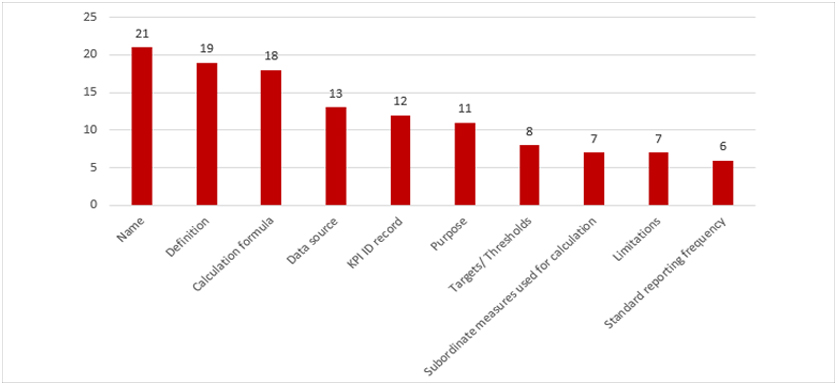Designing efficient KPI documentation forms
 A documentation form is a standardized template used to aggregate all relevant information in regards to a Key Performance Indicator (KPI). It sets the basis for a rigorous performance measurement framework, by providing details about the KPI in terms of description, targets, purpose, limitations and accountability.
A documentation form is a standardized template used to aggregate all relevant information in regards to a Key Performance Indicator (KPI). It sets the basis for a rigorous performance measurement framework, by providing details about the KPI in terms of description, targets, purpose, limitations and accountability.
According to the latest research performed by The KPI Institute, which was based on 21 examples from various industries, organizations use on average 12 different fields to document a KPI. The most popular ones are listed in the graphic above.
The KPI Institute’s research points out that the most common information included in a KPI documentation form can be clustered in 3 categories:
- KPI description – includes fields like KPI ID record, Name, Definition and Purpose;
- KPI measurement – comprises the Calculation formula and the Subordinated measures or parameters used in the computation process. It also consists in a section that indicates the KPI’s target and thresholds;
- Data profile – outlines data sources, its limitations and the reporting frequency of the KPI.
Recommended format of the KPI documentation form
The KPI documentation form should be simple, well structured (the fields could be cluster into sections), and easy to use (it can be an excel document). The recommended structure for a well-designed documentation form is the following:
KPI description
- KPI ID record
- Name
- Definition
- Related objective
KPI measurement
- Calculation formula
- Subordinated measures
- Targets
- Thresholds
Data profile
- Data source
- Standard reporting frequency
- Limitations
Accountability
- KPI owner title
- KPI owner name
- Data custodian title
- Data custodian name
Other comments
The added value of using KPI documentation form
The value added by using KPI documentation forms relates to clarifying what, why and how a KPI is measured. Moreover, it highlights accountability by setting data owners and custodians for each KPI. The data owner is the person responsible for reaching the targets, while the data custodian field indicates the employee that deals with data gathering.
KPI documentation forms ensure a standardized approach in working with KPIs and contribute to building an organizational KPI catalogue that is a valuable source of knowledge in performance management.
References:

Tags: KPI, Performance Measurement




